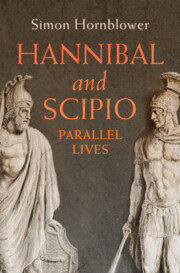Book contents
- Frontmatter
- Dedication
- Contents
- List of Maps
- Preface and Acknowledgements
- Notes for the Reader
- Family Tree 1 Hannibal
- Family Tree 2 Scipio
- Timeline
- List of Abbreviations
- Prologue
- 1 Hannibal and Scipio on Themselves
- 2 Origins: Hannibal: 247–221, Birth to Aged 26 Years, Scipio: 235–218, Birth to Aged 17 Years
- 3 Hannibal Victorious, 221–216: Aged 26–31 Years
- 4 Scipio 216–205: Aged 19–30 Years
- 5 Hannibal Frustrated in Italy, 216–208: Aged 31–39
- 6 Overseas Commands: Freedoms and Perils
- 7 Politics and Factions at Carthage and Rome
- 8 The Tipping Point: The Battle at the Metaurus or Sena, 207, Hannibal Aged 40
- 9 Hannibal and Scipio Meet and Fight at Last: Zama, 202, Aged 45 and 33
- 10 The Religion of Hannibal and Scipio
- 11 Scipio Triumphant, 202–193: Aged 33–42
- 12 Hannibal as Political Reformer at Carthage, 196: Aged 51
- 13 Hannibal, Scipio, and the Greek World
- 14 Hannibal Flees to Antiochus III; His Intrigues; 195–193: Aged 52–54
- 15 Hannibal and Scipio as Military Advisers in the Late 190s: The Road to Magnesia, 190: Aged 57 and 45
- 16 Hannibal and Scipio: The Military Comparison
- 17 Hannibal’s Years of Wandering, 190–183: Aged 57–64
- 18 The Downfall and Death of Scipio, 187–183: Aged 48–52
- 19 Afterlives
- 20 Conclusion: Parallel Lives
- References
- Index
- Frontmatter
- Dedication
- Contents
- List of Maps
- Preface and Acknowledgements
- Notes for the Reader
- Family Tree 1 Hannibal
- Family Tree 2 Scipio
- Timeline
- List of Abbreviations
- Prologue
- 1 Hannibal and Scipio on Themselves
- 2 Origins: Hannibal: 247–221, Birth to Aged 26 Years, Scipio: 235–218, Birth to Aged 17 Years
- 3 Hannibal Victorious, 221–216: Aged 26–31 Years
- 4 Scipio 216–205: Aged 19–30 Years
- 5 Hannibal Frustrated in Italy, 216–208: Aged 31–39
- 6 Overseas Commands: Freedoms and Perils
- 7 Politics and Factions at Carthage and Rome
- 8 The Tipping Point: The Battle at the Metaurus or Sena, 207, Hannibal Aged 40
- 9 Hannibal and Scipio Meet and Fight at Last: Zama, 202, Aged 45 and 33
- 10 The Religion of Hannibal and Scipio
- 11 Scipio Triumphant, 202–193: Aged 33–42
- 12 Hannibal as Political Reformer at Carthage, 196: Aged 51
- 13 Hannibal, Scipio, and the Greek World
- 14 Hannibal Flees to Antiochus III; His Intrigues; 195–193: Aged 52–54
- 15 Hannibal and Scipio as Military Advisers in the Late 190s: The Road to Magnesia, 190: Aged 57 and 45
- 16 Hannibal and Scipio: The Military Comparison
- 17 Hannibal’s Years of Wandering, 190–183: Aged 57–64
- 18 The Downfall and Death of Scipio, 187–183: Aged 48–52
- 19 Afterlives
- 20 Conclusion: Parallel Lives
- References
- Index
Summary
‘Hannibal’s legacy’ is an influential 1965 book by a controversial historian, Arnold Toynbee. It set the agenda for the next half-century and more of scholarship by arguing that the ‘legacy’ consisted of lasting damage to the agricultural economy of Italy and the political stability of Rome. Its contemporary reception is presented and analysed. The (disputed) extent of Italy’s devastation, as divinely promised to Hannibal in an alleged dream while still in Iberia, is assessed, and manpower difficulties discussed. Hannibal’s legacy at defeated Carthage was more obviously damaging, though the city did not fall until 146. Hannibal’s literary legacy in Latin and Greek literature was systematically ambiguous: fear, horror, fascination, and even admiration. Scipio’s literary afterlife and perceived qualities are explored initially through the medium of the ‘Dream of Scipio’, a fictional work by Cicero in imitation of Plato: Scipio Africanus appears to his adoptive grandson Aemilianus in his sleep.
- Type
- Chapter
- Information
- Hannibal and ScipioParallel Lives, pp. 395 - 426Publisher: Cambridge University PressPrint publication year: 2024

